by Charles River Interactive | May 10, 2016 | Organic Search
The Pharmaceutical Industry is one of the most heavily regulated industries in the US. As it involves the topic of human health, it’s not surprising that any marketing activity to promote pharmaceutical products is highly scrutinized. Ensuring that your messaging doesn’t involve any false claims or miscommunicate product information is absolutely critical. This represents a big challenge for marketers. When it comes to SEO, where content really is king, this extra layer of restrictions can become a major obstacle in making a program successful.
With restrictions in mind, SEO can bring a lot of value to the pharmaceutical sites and shouldn’t be ignored. Here are some things to keep in mind if you’re working on a pharmaceutical product.
Multiple domains
In pharmaceutical marketing, healthcare providers and patient audience are typically targeted separately. Which means that you would have to deal with two separate websites, targeting patients and healthcare providers (HCPs). If you’re lucky, they may live on one domain (i.e. example.com/hcp and example.com/patient), which would be more beneficial for your domain authority. However, in most cases, these properties are hosted on completely separate domains with specific HCP or patient content.
In addition to the patient and HCP domains, many pharma brands also opt to have a separate more flexible, unbranded domain to drive awareness about a certain disease. Because this property is unbranded, there is a lot more flexibility to change or update its content. Therefore, a typical SEO program for one pharma product involves at least two to three sites.
Approval process
Keep in mind that any recommendations to update front-end website copy will have to go through legal approval process. This includes all on-page elements, such as title tags, meta descriptions, etc. Therefore, the updates will not happen overnight. In order to speed up the process, make sure that you learn as much as possible about the product and get the legal guidance from your client. In the meantime, you can work on making sure that the site is search-friendly on back-end, as technical recommendations are typically easy to push through as they don’t require legal approval.
Authoritative competition
If you perform a disease-related search query, you will rarely see a pharmaceutical brand ranking in the first three results. The top unbranded positions in Search Engine Result Pages (SERPs) are typically dominated by highly authoritative informational websites, such as WebMD or MayoClinic. This doesn’t mean that you can’t rank on the first page, however, ranking in the first three positions would be extremely challenging.
Google SERP updates
Last year, Google started updating how medical search results are displayed. For example, its Knowledge Graph panel now includes rich content on health conditions, even with downloadable PDFs. There are also “answer boxes” that show up on the first page of search results, directly pulling information from the websites. For example, you will see this “answer box” if you search for “knee pain”.

As users want to get information they’re looking for with the least amount of clicks, these updates are very helpful to them. At the same time, healthcare websites are seeing dips in their organic traffic as a result.
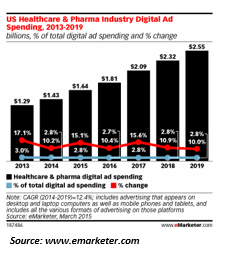
With all these challenges in mind, SEO and digital marketing in general represent a big opportunity for pharmaceutical companies. Recent eMarketer data shows that the digital ad spending keeps growing exponentially and is projected to grow.
As marketers, we understand the challenges and can customize smart SEO strategies that drive highly relevant traffic to Pharmaceutical sites.
Interested in learning more about SEO? Read more from our blog, View from the Charles:
How Does the New Google Ad Layout Impact SEO?
Google SERP News: Right Rail Ads are Gone
Want more information? Get more details on Charles River Interactive’s SEO and PPC service offerings or contact us today.
by Charles River Interactive | April 29, 2016 | Organic Search, SEO, SEO Blogs, Uncategorized
No website is perfect. But of all the potential issues that could affect user experience, none is so obvious as the one that announces itself: the 404 error. If a user encounters this issue on your or your client’s site, the server will clearly state there is a problem, usually with some variation of “404 error: Page not found.”
If you manage a very large site, 404 errors are inevitable at some point. The key is establishing a process to find and resolve them quickly and efficiently.
What is a 404 Error?
A 404 error is a page that was not properly removed from a website or redirected in your content management system (CMS). As a result, the page appears to live on the website, but it no longer exists on your server. If a user tries to visit the page, they receive an error message.
Regularly resolving your site’s 404 errors is a signal to Google that you are maintaining a healthy website. It also improves user experience by minimizing the number of broken pages visitors may encounter.
Tips for Managing 404 Errors
- Prioritize: If you have a large site with hundreds of 404 errors, the best option is to prioritize your efforts. Use Google Analytics (or your preferred web analytics platform) to evaluate how much organic traffic each 404 page has received over a predetermined period of time. Tackle the pages with the most traffic first, and work your way down.
- Automate: You can automate redirects using the .Htaccess file in your CMS. Choose which page you want to be the replacement for a 404 error page. It may be a custom redirect page, or you may want to send users back to your homepage or to a search function. Please note: An .htaccess file is an extremely sensitive file in your CMS. We highly recommend your IT department sign-off on any edits to an .htaccess file.
3 Tools for Fixing 404 Errors
Outlined below are some tools to effectively find and resolve 404 error pages.
Google Webmaster Tools
Google Webmaster Tools (a.k.a. Search Console) is a resource from Google that web developers use to monitor website issues and control how their sites appear in search results.
Assuming your GWT is verified, here are the steps you take:
1. Login
2. Select your domain
3. Select ‘Crawl’ on the left sidebar
4. Crawl Errors
5. Select ‘404 Errors’
6. Select ‘Download’ to export as Excel/CSV file
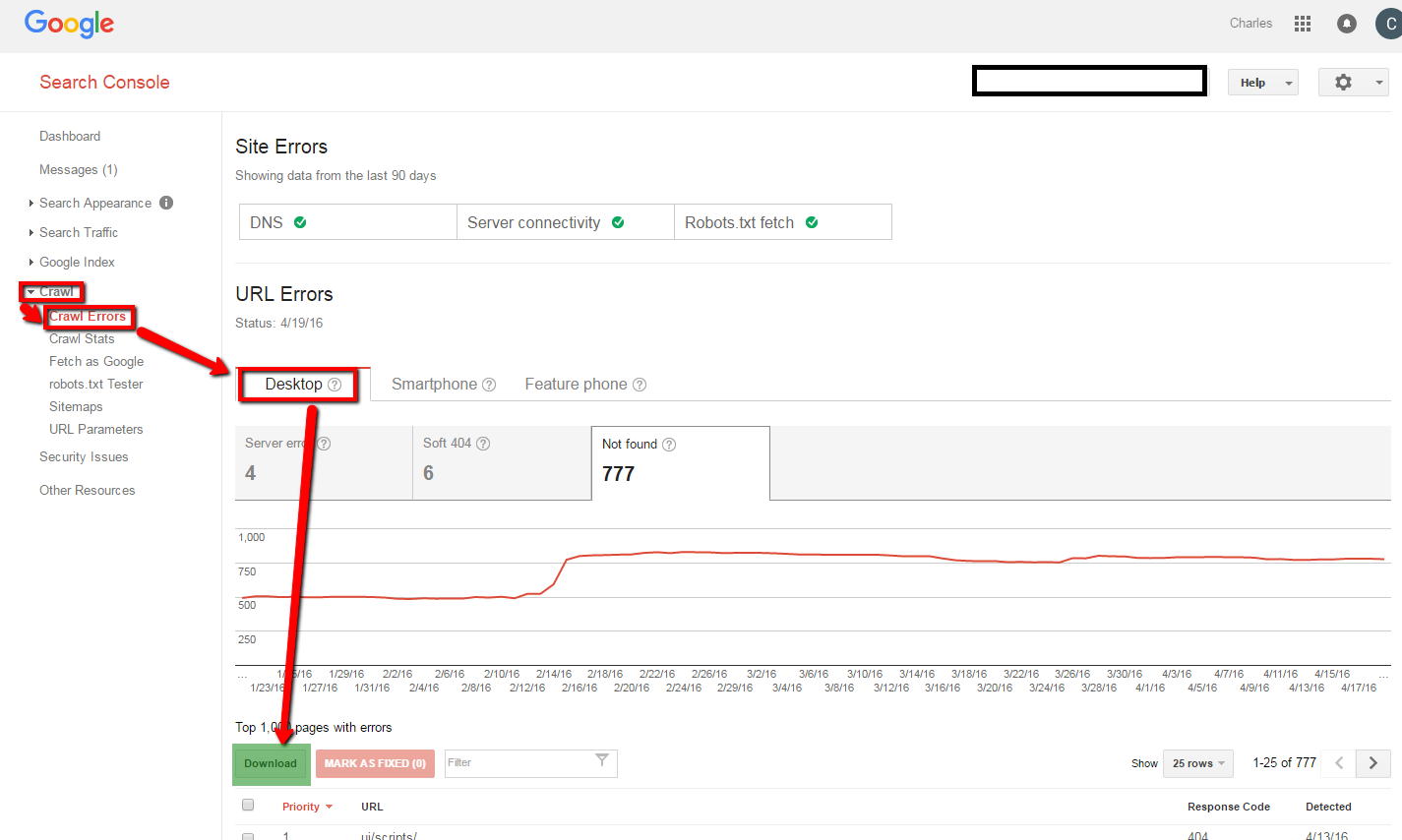
Screaming Frog (free and paid versions)
Screaming Frog’s SEO Spider is a tool that allows you to easily crawl hundreds of URLs for 404 errors. The free version will crawl up to 500 URLs; the paid version will crawl an unlimited number across your entire website. You just enter the URLs and the program creates a file ready for export.
Yoast SEO for WordPress (free and paid versions)
If you host your entire site or blog on WordPress, Yoast SEO (formerly known as WordPress SEO by Yoast) is a tool that can help you configure your pages for SEO. This plugin, which you download, allows you to edit your URLs, meta data, XML Sitemaps, as well as monitor for 404 errors via integration with Google Webmaster Tools. The premium version is available for $69/year for one site.
When to Use 301 Redirects
We highly recommend 301 redirects when you want to redirect individual pages or even entire websites. A 301 redirect is a permanent redirect from one URL to another. These types of redirects are especially useful when the missing page enjoyed a high organic search rank on search engines. The new, 301 redirect page maintains the SEO strength of the link even when redirected.
Sometimes there isn’t a good page to redirect to. In this case, a custom error page should be provided.
Creating Custom 404 Pages
If a permanent 301 redirect does not make sense, then you can consider creating a customized, visitor-friendly error page to appear in place of the missing URL. Typically, website use the same custom page across the site for 404 errors.
Custom error pages typically feature the following:
- A message to the user explaining that the page no longer exists
- A search box to help a visitor find exactly what they want
- A link to the home page
We hope this has been a helpful tutorial on how to find and fix 404 pages.
You can make it even easier on yourself and have Charles River Interactive give your site an in-depth SEO Analysis. Contact us today.
Interested in learning more tips for managing your website? Read more from our blog, View from the Charles:
3 Reasons to Use Google Tag Manager
Mobile Search Updates: Why You Need a Mobile Site
by Charles River Interactive | March 21, 2016 | Content Marketing, Organic Search, Paid Social
Co-authored by Nancy Stewart
We reported last month on big developments with Twitter (#RIPTwitter: The Future of Twitter and Your Brand) and how they could change the content marketing landscape.
Our conclusion? There’s a lot of opportunity here for smart marketers – despite the critics who fear any change to the Twitter algorithm. The rules are still the same: Really compelling, targeted, organic content is your best bet for attracting followers, building engagement and achieving conversions.
Where do you start? We’ve compiled our top 10 Twitter tips (with a bonus tip) to help you develop a smart strategy.
How to Use Twitter for Your Brand
If you want Twitter to be a successful tool for your business, you need to have a plan before you start tweeting away.
Even the most eloquently-crafted 140-character posts will not attract followers and achieve real results on their own. Creating and implementing a smart content strategy will go a long way to keep your Twitter account focused on your business objectives and directed at your target audience.
- Lay out your goals: You’ll have more success creating effective tweets if you know why you are tweeting. Your posts should support your business goals for using Twitter. Start by answering a basic question: What are you trying to do? The answer may be build brand awareness, promote thought leadership or generate leads. Make sure your content supports those goals.
- Target your audience: Before posting any tweet, ask yourself: “What information does my target audience want and do they care about this message?” It’s a good idea to tweet about topics you’ve seen resonate with your followers in the past. These easy tricks can help you acquire a more targeted following.
- Find your voice: Central to building a brand presence on any social media platform is having a personality. How do you want followers to perceive your brand? Are you fun, creative, humorous? You convey that personality by picking the best voice and tone and staying consistent.
- Get creative with #hashtags: You’ve seen them, but do you know to use them? Hashtags are keywords or phrases that help your posts reach the right people. Research the most popular hashtags related to your industry. Once you’re established on Twitter, you can even create your own hashtags.
- Use visuals: Stop thinking about Twitter as a space that only allows text. Uploading images, GIFs and videos help your posts stand out and increase engagement significantly.
- Develop an editorial calendar: Feeling overwhelmed with the need to post to Twitter, Facebook, your blog and so on? Editorial calendars help you get organized and post regularly on a schedule, so you don’t fall behind.
- Be interactive: By nature, social media isn’t supposed to be a one-way conversation. Make sure you are giving back to your followers by responding to them, re-tweeting them, etc. If you tweet content from other sources (besides your own blog), be sure to mention and tag authors and publications.
- Engage with influencers: Identify a list of reputable individuals or businesses with a particular expertise that’s relevant to your brand. When an opportunity arises to reply or retweet, take it! You can also keep an eye on what the industry experts are tweeting and mention them in tweets you feel they’d be interested in.
- Include a clear call to action: The best way to achieve a direct response is to be explicit. If you have only 140 characters, don’t be coy or shy. “Read more at our blog” or “Visit our online store” are effective approaches when you pair them with a compelling reason why: “Get ready for summer. We’re offering 20 percent off all sandals today. Visit our online store.”
- Be brief: This one goes without saying, since the hallmark of Twitter since its launch was the 140-character-limit. You may feel the squeeze to stay within those boundaries, but know this: Shorter Tweets – 140 characters or less – get more conversions. That’s according to Twitter’s own best practices guide.
And a bonus 11th tip:
Pay to promote your Tweets: Even a small investment in paid social can help drive traffic. Promote tweets with high engagement rates to extend your reach and continue providing your target audience with particularly engaging content.
Interested in learning more about social media and paid search trends? Read more from our blog, View from the Charles:
How To Use Snapchat For Your Brand
Google SERP News: Right Rail Ads Are Gone
by Charles River Interactive | March 15, 2016 | Organic Search, Uncategorized
A couple weeks back, Google confirmed that it was removing ads from the right hand side of desktop search results. This change happened pretty quickly and led to a lot of conversations around what this meant for paid search.
But a lot of questions have also surfaced around how this change would impact SEO. Some are calling SEO the loser in all of this, while others are viewing this as an opportunity for SEO to be a winner.
Google’s Changes and SEO: 3 Facts to Know
It does not appear that these ad layout changes will change search results for most users. In fact, some users will get an improved experience. Let’s look at the facts:
- Google is bigger on mobile than desktop: Last year, Google confirmed that more searches happen on a mobile device – which never had the right rail ads – than on a desktop. That means, Google’s top users will not be impacted by this change.
- New paid search ad space only affects “highly commercial queries”: That is, searches where Google believes the user’s goal is to make a purchase. The four paid search ads at the top of the page will relate to those types of searches.
- Google values user experience: Google made this update to improve the user experience, and it demonstrates they are committed to searcher intent. By focusing on highly commercial queries, Google looks to give searchers with the intent to make a purchase more relevant ads.
Google’s Ad Layout and Organic Search: What Happens Now?
We know that the changes will affect SEO, but it isn’t yet clear to what extent. What we know for certain is that Google will continue to make changes that focus on a better user experience. If you want to stay ahead of the game, you should always put time into implementing a solid SEO strategy.
Let’s review some key points for you to consider:
- Space just got far more competitive for organic
What was formerly the top organic search result for a highly commercial query (where purchase is the intent) is now the fourth paid search ad. Research shows that the further down a result appears in the Search Engine Results pages (SERPS), the fewer clicks it receives. Now, organic search results may display below the fold on desktop searches specific to these queries. Previously, organic search results received as many as 70 percent of clicks. It will be interesting to see if this stat changes.
- Expect to see more from the Knowledge Graph
The removal of the right rail ads frees up a lot of space in the SERPS for more information to populate in the Knowledge Graph panel. Again, since Google is all about focusing on user intent and getting users accurate information as soon as possible, the Knowledge Graph feature is expected to become more prominent. We’ve already seen different versions of this panel, including the Health Conditions Knowledge Graph, which rolled out last year. So this is a critical time to focus on getting your local search efforts intact and your schema markup in place to take advantage of this newly open real estate.
Interested in developing a better understanding of Google as a marketer? Read more from our blog, View from the Charles:
Google SERP News: Right rail ads are gone
How to Launch Smarter Campaigns with Google Customer Match
by Charles River Interactive | February 23, 2016 | Industry Trends, Organic Search, Paid Search
As of Monday, Google has confirmed a huge adjustment to search results: right hand rail ads are disappearing.
Last week, on Feb. 18, a dramatic increase in SERPs (marketing lingo for Search Engine Results Pages) with four ad positions, as well as a slow but noticeable decline in right rail placement, led many PPC leaders to question if the change was finally happening. Hinted at last December, when Google began beta testing four ad SERPs alongside Shopping PLAs across a very limited number of results, this update is a game-changer for search engine marketing as a whole.
Why is Google Removing Right Rail Ads?
Google claims the new layout will help searchers find (read: click on) more relevant and engaging content. But the change suggests an effort by Google to standardize the advertising ecosystem across all devices – mobile, desktop, and tablet – by serving the same number and style of ads in the top results. While this makes room for a variety of right rail results such as Knowledge Panels and Shopping PLAs on desktop, the effects on paid advertisers will be swift and global.
Google SERP Before
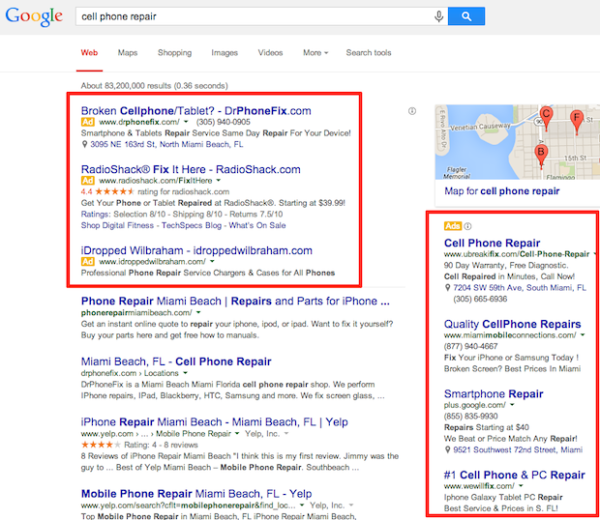
Google SERP After
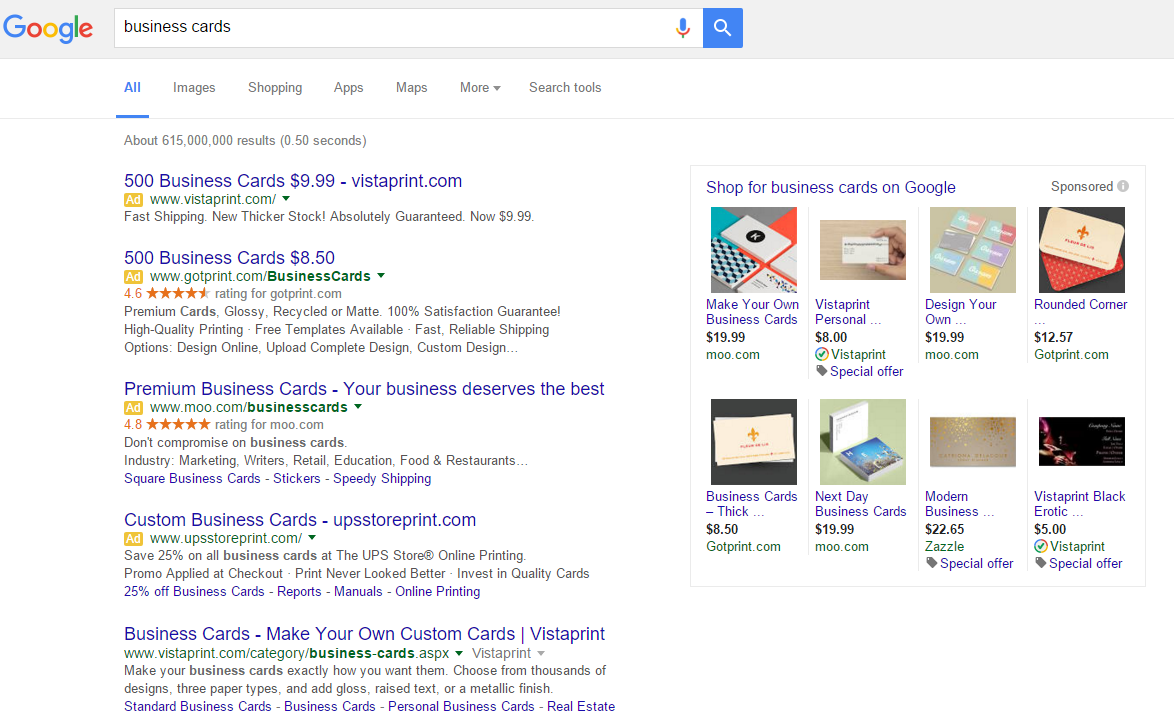
Top 3 Changes in Google’s New Ad Layout
So what do the changes mean for paid search? Here are the most dramatic potential changes:
- Cost-Per-Click Increases: With the number of paid advertisements decreasing, competition for those top spots just got hotter. The potential for a rise in CPCs across all SERPs is a possibility, as companies compete for an even smaller advertising space. Not to mention the effects of bidding for a top 4 spot, only to find oneself in spot no. 5, now at the very bottom of the first search result page.
- Higher Competition for fewer Ad Spots: While adding a fourth spot is good, total paid listings has decreased from approximately 10 to 7. This puts even more pressure on appearing in those top four spots.
- Less Above-the-Fold Real Estate for Organic Results: An additional ad pushes all organic listings further down a page already chock full of PPC, Google My Business results and Local Packs. While overall organic strategy shouldn’t see any seismic shifts, there is opportunity to adjust SEO tactics to focus on long-tail term optimizations (in addition to more competitive ad-filled SERP keywords), so that your business can continually increase traffic from all positions in the search funnel.
How does the Google Ad Layout Impact Paid Search?
It’s estimated that 85 percent of clicks came from the top ads and only about 15 percent came from the side and bottom ads. The data shows that right rail ads have a much lower likelihood of a click regardless of position, and the fight has always been for top three spots.
So now we’ll have an extra spot to bid for, as well as shopping PLAs and Knowledge Graphs on desktop (when applicable). Quality Scores and efficiencies will be more important than ever, and other factors such as search relevancy and ad copy, are expected to become increasingly more influential in advertisers’ ability to efficiently maintain position in the top four ad spots, while successfully driving traffic to their site.
Google is telling us loud and clear that good, relevant ads will be rewarded with coveted top positions for an affordable price. All you have to do is listen!
Interested in learning more in paid search and SEO trends? Read more from our blog, View from the Charles:
How to Launch Smarter Campaigns with Google Customer Match
Optimizing for Voice Search
by Charles River Interactive | January 18, 2016 | Industry Trends, Organic Search
What is a mobile messaging app?
Digital marketing reports have suggested that mobile chat is the “next killer app” for 2016. Mobile messaging apps are a cost effective way to send messages and media in real-time from sender to receiver on a mobile device. Unlike smartphone text messages, mobile chat apps are free stand-alone programs that have evolved into mini-platforms, incorporating a wide set of tools like built-in web browsing, shopping, payment options, online communities, web-based video, and on-demand communication. In 2015, AdAge reported that the main contenders in the U.S mobile messaging app space are Facebook Messenger, Snapchat, and WhatsApp. However, Adweek’s 2016 predictions suggest that global players like WeChat, Line, Kik, and Viber are beginning to become popular among brand marketers and millions of millennials. Most of these mobile messaging apps have similar features, but each offer different tools that impact the way businesses and users engage on these platforms.
Most popular global messenger apps, based on a number of monthly active users.
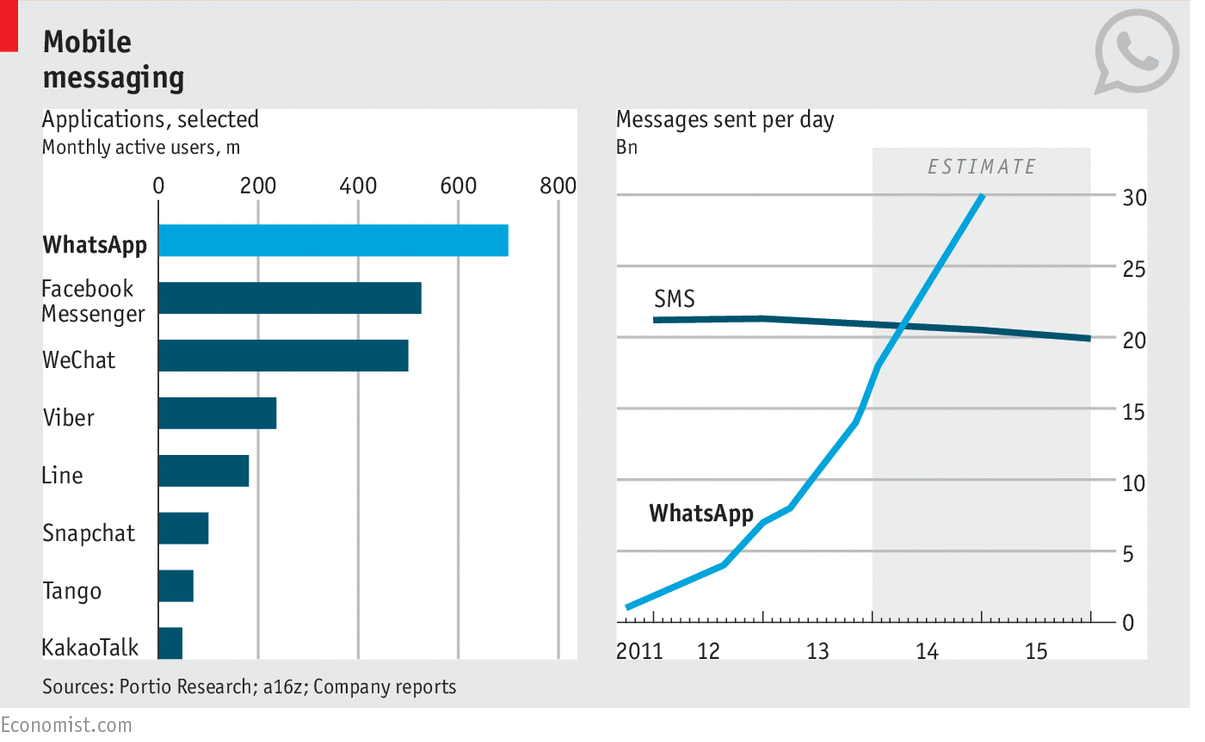
What does this mean for Google?
The Wall Street Journal recently reported that Google is developing a new mobile chat app in efforts to maintain its position as a top search tool. Although Google’s new service is still in the works, reports have suggested that Google plans to develop an “artificial intelligence-enhanced” platform to contend with Facebook owned WhatsApp and Messenger. In fact, The WSJ suggests that Google’s new app would enable users to message one another or a chatbot, a computer program that engages in human conversation. These chatbots have the ability to figure out a range of appropriate responses and remember earlier conversations. For instance, chatbots can help a human troubleshoot IT problems. This way, users won’t have to leave the app to discover new information.
How does mobile messaging apps benefit clients?
According to research conducted by Activate, Inc., mobile messaging apps have grown with 2.5 billion registered users in 2015 and an additional 1.1 billion new users expected by 2018. Mobile chat is a powerful tool for businesses because the stats show consumers prefer to be engaged in this manner. While messaging apps provide excellent personal support, eliminate phone calls, and foster consumer-brand relationships, there are additional benefits for businesses. Given that consumers look to brands to meet immediate needs, mobile chat apps offer an interface for a customer to ask what they want on-demand in a comfortable space. That is, brands can now reach consumers during their purchasing decisions. In addition, specific features of mobile messaging apps give connected consumers access to essential store and product information like inventory availability, product reviews, and a user-friendly shopping cart. With that, mobile messaging platforms provide an opportunity for businesses to tailor their digital marketing strategies in way that will organically insert themselves into mobile conversations.






